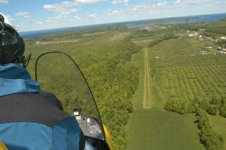- Joined
- Oct 30, 2003
- Messages
- 18,374
- Location
- Santa Maria, California
- Aircraft
- Givens Predator
- Total Flight Time
- 2600+ in rotorcraft
Quote from Doug Riley from the thread on Pre-rotate before entering runway
“I try to inform FW pilots who might be using the runway at the same time as me about my operating needs. I bring it up at the morning pilots' briefings at flyins, for example. The "special needs" I announce include (1) the delay caused by prespinning, (2) my close-in patterns, and (3) very steep approaches.(#3 has caused more trouble than anything else; I've had fast FW planes do their finals UNDER me and land in FRONT of me while I'm on short final in a gyro. They are watching the numbers and don't look ABOVE them for something descending steeply toward the same spot. I've developed the habit of frequently turning around and looking behind me, up the "10-mile final" glide slope when on final. Many fixed-wingers turn final in the next county over.”
Doug brings up a good point that was not really a part of the topic of this thread so I am going to take it to Training.
In my opinion flying a close in pattern has some specific value at non towered airports that sometimes can get lost over time.
Early on many of my clients will focus on the runway when turning base to final so they don’t overshoot the runway instead of looking closely at the approach path for aircraft on a big pattern or making a straight in.
As Doug writes the fixed wing pilots are focused on their aiming point and likely will not see a gyroplane descending into their approach path.
I encourage all gyroplane pilots to start searching the approach path as soon as they turn bass and take a last careful look before turning final.
I remind them that there is no requirement for someone to use a radio at a non towered airport so see and avoid is the primary tool.
It is my observation that often fixed wing pilots will report their final incorrectly and may in fact be much closer than they report.
Many fixed wing pilots imagine that gyroplanes are flying the same pattern at the same speed and when I report midfield, downwind they may imagine they have more time than they do.
If they are reporting by the Aeronautical Information Manual (AIM) I make certain I have them in sight and can extend my downwind if there is a conflict.
If there is a mid air collision likely all aboard both aircraft will receive fatal injuries so they too are motivated to see and avoid.
I feel this is important even at an airport with an operating control tower because air traffic controllers are not perfect and the consequencies of a mistake are dire.
Last edited:

